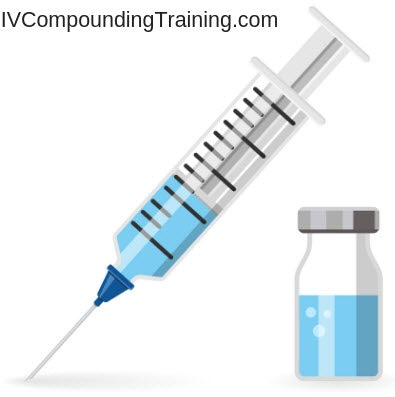Click this link to sign up for the IV certification courses
Cleaning A Compounding Isolator
Cleaning a Compounding Isolator: Best Practices & Compliance Guidance
Cleaning and maintaining a compounding isolator is a critical component of sterile compounding compliance. A well-maintained isolator minimizes contamination risk, supports a validated environment, and helps your facility meet USP <797>/<800> requirements. This guide walks through the key considerations, step-by-step procedures, and documentation practices to ensure your isolator stays in control.
Why Cleaning a Compounding Isolator Matters
A compounding isolator (often a Compounding Aseptic Isolator or CACI/CAI) is a primary engineering control designed to provide an ISO Class 5 environment for sterile compounding. See FDA aseptic processing guidance.
Because the isolator protects both the product and the operator (especially when handling hazardous drugs), any residual contamination, lint, chemical residue or microbial burden can compromise sterility assurance. Cleaning therefore is not optional—it is foundational to risk management, qualification and ongoing validation.
Under USP <797> you must have standard operating procedures (SOPs) for cleaning and disinfecting the compounding area (including the isolator), documentation of competency, and logs of cleaning/disinfection. See Aseptic Enclosures.
Regulatory & Standards Background
- USP <797> mandates that compounding personnel be trained in cleaning/disinfection of sterile compounding areas. (USP.org)
- FDA cGMP guidance for aseptic processing includes isolator cleaning—surfaces must meet critical cleanliness conditions. (FDA.gov)
- Industry guidance for CAIs/isolators emphasizes cleaning at beginning of shift, between batches, and for background areas. (PPPMag)
- Materials of construction must withstand repeated cleaning/disinfection. (VestiLab TechNote)
Key Components of an Isolator Cleaning Program
1. SOPs and Documentation
- Written cleaning/disinfection procedures specifying what, how, when, and with which products.
- Defined frequencies (start of shift, between batches, daily/weekly/monthly tasks).
- Approved cleaning logs/checklists with sign-off.
- Training and competency documentation for personnel performing the cleaning.
- Material compatibility documentation for cleaning agents.
2. Cleaning Materials and Agents
- Use low-linting, non-shedding polyester wipers inside isolators; avoid cotton.
- Use an appropriate cleaning detergent followed by disinfectant (e.g., 70% IPA) and rinse as required.
- Ensure agents are compatible with surfaces, gloves, and seals.
- Introduce pre-sterilized wipes via transfer devices to maintain asepsis. (VestiLab)
3. Cleaning Frequency and Sequence
- Beginning of shift: clean all interior surfaces before compounding. (PPPMag)
- Between batches: wipe down surfaces, change gloves, disinfect spills.
- After spills or contamination: immediate cleaning/disinfection and documentation.
- Background area cleaning: floors, walls, pass-thru areas daily. (Aseptic Enclosures)
- Periodic deep cleaning: ceilings, exteriors, vents monthly or per manufacturer guidance.
4. Cleaning Technique and Workflow
- Clean from clean ➜ dirty, top ➜ bottom.
- Use overlapping linear strokes; refold wipers frequently.
- Avoid excess liquid to prevent pooling or residues.
- Use swabs for corners, joints, and under equipment. (Aseptic Enclosures)
5. Disinfection and Validation
- After detergent cleaning, apply disinfectant (70% IPA or sporicidal agent) with full contact time, then rinse if required. (VestiLab)
- Ensure full surface coverage including gloves, sleeves, and pass-thrus.
- Validate through environmental monitoring (microbial/particle counts). (FDA.gov)
6. Glove Ports, Sleeves, and Changeover
Inspect glove ports and sleeves for integrity at start of shift or after interventions. Wipe gloves frequently, replace as needed, and record inspections. (FDA.gov)
Step-by-Step Cleaning Procedure
Step 1: Pre-Cleanup Preparation
- Stop compounding; close transfer ports.
- Gown and glove per SOP.
- Gather approved cleaning supplies and inspect glove integrity.
Step 2: Detergent Cleaning
- Wipe interior surfaces (walls, ceiling, windows, ports, work surface) top to bottom.
- Change wiper after each pass; remove visible residues.
- Rinse with sterile DI water or 70% IPA to remove detergent residues.
Step 3: Disinfection
- Apply disinfectant with contact time; rinse if needed.
- Pay special attention to glove ports and corners.
- Close isolator and purge if required by manufacturer.
Step 4: Documentation
- Record date/time, initials, glove inspection results, observations, and any deviations.
- Supervisor review and QA retention.
Step 5: Between-Batch Cleaning
- After each batch, wipe work surfaces and gloves with 70% IPA.
- Dispose of used wipes per policy; inspect for residue.
Step 6: Scheduled Deep Cleaning
- Monthly/quarterly: clean ceilings, walls, pass-thrus, vents, exteriors.
- Check door seals, glove ports, filters, airflow performance.
Common Pitfalls & Corrective Actions
- Low-quality wipes: may shed fibers—use polyester knit. (VestiLab)
- Skipping rinse step: leaves detergent residues—always rinse with sterile DI or IPA.
- Inconsistent frequency: adhere strictly to schedule. (PPPMag)
- Poor documentation: missing logs or signatures undermine compliance.
- Ignoring glove integrity: inspect regularly and log findings. (FDA.gov)
- Incompatible disinfectants: verify with manufacturer guidelines. (VestiLab)
Training & Competency
- Provide structured training covering cleaning/disinfection sequence, agents, glove checks.
- Conduct hands-on competency assessments using checklists.
- Renew competency annually and retain records for audits.
- Post visual aids in the cleanroom for quick reference.
Integration Into the CSP Program
- Include cleaning procedures in the CSP SOPs.
- Correlate environmental monitoring results with cleaning frequency.
- Bundle cleaning and glove integrity logs for QA review.
- For hazardous drugs, verify compliance with USP <800> residue removal standards.
Business Benefits
- Reduces contamination risk and audit findings.
- Extends equipment lifespan and minimizes downtime.
- Improves quality culture and staff confidence.
Conclusion
Cleaning a compounding isolator requires a structured, documented program based on regulatory standards, competent personnel, validated cleaning agents, and disciplined technique. When executed correctly, it safeguards product sterility, supports compliance, and ensures patient safety. Implementing standardized SOPs, training, documentation, and periodic review will anchor your isolator cleaning as a core element of your sterile compounding quality system.
Example video of how to clean a compounding isolator. Always follow your facility’s procedure consistent with state and federal laws.
